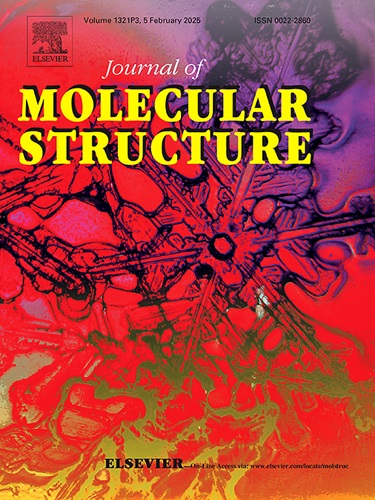双配体三唑硫酮修饰氧化石墨烯对铜(Ⅱ)的选择性吸附性能及其机理
IF 4
2区 化学
Q2 CHEMISTRY, PHYSICAL
引用次数: 0
摘要
以3-甲基异丁基黄药-4-氨基-1,2,4-三唑-5-硫酮(MIBuXATT)为配体,将氧化石墨烯(GO)功能化,合成了一种新型复合材料MIBuXATT@GO,用于高效吸附Cu(II)离子。该改性材料作为吸附剂,通过物理吸附机制和化学吸附机制的协同作用,增强了对废水中Cu(II)的选择性吸附。通过XRD、SEM/EDS、FTIR对MIBuXATT@GO进行了表征。在最佳条件下(pH=4,吸附剂用量250 mg/L,接触时间60 min),该材料对Cu(II)的最大吸附量为97.24 mg/g,是GO的1.3倍。同时,MIBuXATT@GO对Cu(II)的吸附过程为自发吸热化学吸附。此外,关于金属离子吸附选择性的实验结果表明,MIBuXATT@GO对Cu(II)的选择性优于Mn(II)、Zn(II)、Co(II)和Ni(II),优于GO。结果表明,MIBuXATT@GO是一种很有前途的吸附剂,具有高容量、快速动力学和优异的选择性。通过红外光谱(FTIR)、紫外光谱(UV)、XPS和DFT计算分析了其吸附机理,揭示了硫代羰基和三唑-硫酮官能团在Cu(II)配位中的关键作用。本研究为设计高效的重金属离子吸附剂提供了新的思路。本文章由计算机程序翻译,如有差异,请以英文原文为准。

Enhanced selective adsorption properties of graphene oxide modified with bi-ligand triazole-thione compounds for Cu(Ⅱ) and its mechanism
A novel composite material, MIBuXATT@GO, was synthesized by functionalizing graphene oxide (GO) with a bi-ligand triazole-thione ligand, 3-methyl isobutylxanthate-4-amino-1,2,4-triazole-5-thione (MIBuXATT), for the efficient adsorption of Cu(II) ions. This modified material served as an adsorbent to enhance the selective adsorption of Cu(II) from wastewater by synergistically combining physical and chemical adsorption mechanisms. MIBuXATT@GO was characterized by XRD, SEM/EDS, and FTIR. Under the optimal conditions (pH=4, adsorbent dosage 250 mg/L, contact time 60 min), the maximum adsorption capacity of Cu(II) by the material is 97.24 mg/g, which is 1.3 times higher than that of GO. Meanwhile, the adsorption process of MIBuXATT@GO to Cu(II) is characterized as spontaneous endothermic chemisorption. Furthermore, the experimental results regarding metal ion adsorption selectivity indicate that MIBuXATT@GO exhibits superior selectivity for Cu(II) compared to Mn(II), Zn(II), Co(II), and Ni(II), which is an improvement over GO. The results indicate that MIBuXATT@GO is a promising adsorbent for the removal of Cu(II) ions from aqueous solutions, offering high capacity, rapid kinetics, and excellent selectivity. The adsorption mechanism was elucidated through FTIR, UV, XPS, and DFT calculations, revealing the critical role of the thiocarbonyl and triazole-thione functional groups in Cu(II) coordination. This work provides a new strategy for designing efficient adsorbents for heavy metal ion removal.
求助全文
通过发布文献求助,成功后即可免费获取论文全文。
去求助
来源期刊

Journal of Molecular Structure
化学-物理化学
CiteScore
7.10
自引率
15.80%
发文量
2384
审稿时长
45 days
期刊介绍:
The Journal of Molecular Structure is dedicated to the publication of full-length articles and review papers, providing important new structural information on all types of chemical species including:
• Stable and unstable molecules in all types of environments (vapour, molecular beam, liquid, solution, liquid crystal, solid state, matrix-isolated, surface-absorbed etc.)
• Chemical intermediates
• Molecules in excited states
• Biological molecules
• Polymers.
The methods used may include any combination of spectroscopic and non-spectroscopic techniques, for example:
• Infrared spectroscopy (mid, far, near)
• Raman spectroscopy and non-linear Raman methods (CARS, etc.)
• Electronic absorption spectroscopy
• Optical rotatory dispersion and circular dichroism
• Fluorescence and phosphorescence techniques
• Electron spectroscopies (PES, XPS), EXAFS, etc.
• Microwave spectroscopy
• Electron diffraction
• NMR and ESR spectroscopies
• Mössbauer spectroscopy
• X-ray crystallography
• Charge Density Analyses
• Computational Studies (supplementing experimental methods)
We encourage publications combining theoretical and experimental approaches. The structural insights gained by the studies should be correlated with the properties, activity and/ or reactivity of the molecule under investigation and the relevance of this molecule and its implications should be discussed.
 求助内容:
求助内容: 应助结果提醒方式:
应助结果提醒方式:


